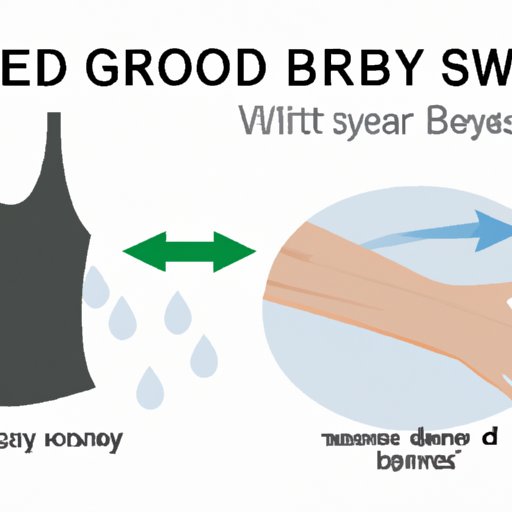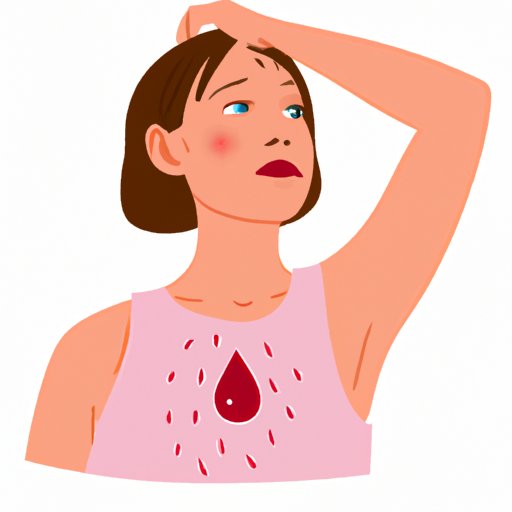I. Introduction
Excessive sweating, or hyperhidrosis, affects millions of people worldwide and can be a source of discomfort, embarrassment, and even social anxiety. While sweat is a natural and necessary function of the body, excessive sweating can interfere with daily activities and lead to unpleasant sweat stains and odors. This article is designed to provide helpful tips and effective solutions for controlling excessive sweating and improving overall comfort and confidence.
II. 10 Simple Tips to Control Excessive Sweating
1. Use antiperspirant: Antiperspirants work by clogging the sweat gland ducts and reducing sweat production. Apply at night before bed for best results.
2. Wear loose-fitting, breathable clothing: Tight clothing can trap sweat and increase body temperature. Opt for loose-fitting, breathable materials like cotton to allow air flow and reduce sweat accumulation.
3. Keep a sweat journal: Tracking sweating patterns can help identify triggers and provide insight into effective solutions. Note important details like time of day, location, activity, and emotional state.
4. Stay hydrated: Drinking plenty of water can help regulate body temperature and reduce excessive sweating.
5. Avoid spicy foods and caffeine: These can increase body temperature and stimulate sweat glands.
6. Use sweat-proof undershirts: Sweat-proof undershirts like Thompson Tee and Ejis can prevent underarm sweat stains and keep clothing dry.
7. Take cool showers: Cool showers can lower body temperature and reduce sweat production.
8. Apply talcum powder: Talcum powder can help absorb moisture and reduce sweat accumulation.
9. Practice relaxation techniques: Stress and anxiety can trigger sweating. Practice relaxation techniques like deep breathing, meditation, and yoga to reduce stress levels.
10. Use shoe inserts: Shoe inserts like Odor-Eaters can absorb moisture and reduce foot odor and sweating.

III. Say Goodbye to Underarm Sweat Stains: Effective Solutions
Underarm sweat stains are a common problem for many people with excessive sweating. These stains can be difficult to remove and can lead to embarrassment and self-consciousness. Fortunately, there are several effective solutions for preventing and removing underarm sweat stains.
First, consider using sweat-proof undershirts like those mentioned above. These shirts are designed to prevent sweat from reaching clothing, reducing the likelihood of sweat stains.
For stains that have already formed, try using a stain remover like OxiClean or vinegar and baking soda. Gently rub the stain with the solution and wash as usual.
If all else fails, consider investing in a sweat-proof garment like the Thompson Tee or Ejis undershirt. These shirts contain advanced sweat-wicking technology to keep you dry and comfortable all day long.
IV. From Antiperspirants to Clothing Choices: Beating Sweat with Science
Antiperspirants are one of the most common methods of controlling excessive sweating. But how do they work? Antiperspirants essentially block the sweat glands, reducing the amount of sweat that is produced. They contain aluminum-based compounds that dissolve on the skin and form a gel-like substance that clogs the sweat gland ducts. This prevents sweat from reaching the skin’s surface and reduces the amount of bacteria that cause odor.
In recent years, there have been significant advancements in sweat-wicking clothing. These materials are designed to draw sweat away from the skin and allow it to evaporate more quickly. Some popular sweat-wicking fabrics include polyester, nylon, and spandex.
V. Natural Remedies for Hyperhidrosis: Stop Sweating Without Harsh Chemicals
For those who prefer natural remedies, there are several options for controlling excessive sweating without harsh chemicals or medications.
One popular natural remedy is sage tea. Drinking sage tea has been shown to reduce sweating by up to 50% in some cases. Simply steep a tablespoon of dried sage leaves in hot water for 5-10 minutes and drink twice a day.
Another natural remedy is apple cider vinegar. Applying apple cider vinegar to the underarms can help balance the pH of the skin and reduce bacteria that causes odor. Mix equal parts water and apple cider vinegar and apply with a cotton ball.
Other natural remedies for excessive sweating include tea tree oil, witch hazel, and cornstarch. It’s important to note that while natural remedies can be effective, they may not work for everyone and should not replace medical treatment for hyperhidrosis.
VI. Lifestyle Changes to Reduce Sweat Production: A Comprehensive Guide
Lifestyle changes can significantly impact sweat production and reduce excessive sweating. Here are some simple changes you can make to your daily routine:
– Exercise regularly to improve overall health and reduce stress levels
– Avoid hot environments and saunas
– Wear breathable clothing and avoid tight-fitting clothing
– Manage stress with relaxation techniques like meditation and deep breathing
– Shower immediately after exercising or sweating
– Stay hydrated
VII. How to Stop Sweating in Social Situations: Strategies for Confidence and Comfort
Excessive sweating can be a significant source of social anxiety for many people. Here are some strategies for coping with sweating in social situations:
– Wear breathable clothing and bring an extra shirt or two in case of excessive sweating
– Use antiperspirant and consider carrying deodorant or wipes with you
– Find ways to stay cool, like carrying a handheld fan or staying in air-conditioned areas
– Practice positive self-talk and focus on your strengths rather than your sweating
– Seek support from friends, family, or a mental health professional if social anxiety becomes overwhelming
VIII. Conclusion
Excessive sweating can be a challenging and uncomfortable problem, but there are many effective solutions for controlling sweat production and improving overall comfort and confidence. From simple tips like wearing breathable clothing and using antiperspirant, to natural remedies like sage tea and apple cider vinegar, there are many options to choose from. It’s important to work with a healthcare provider to determine the best treatment plan for your individual needs. With a little experimentation and patience, you can find the right approach for you and say goodbye to excessive sweating once and for all.
